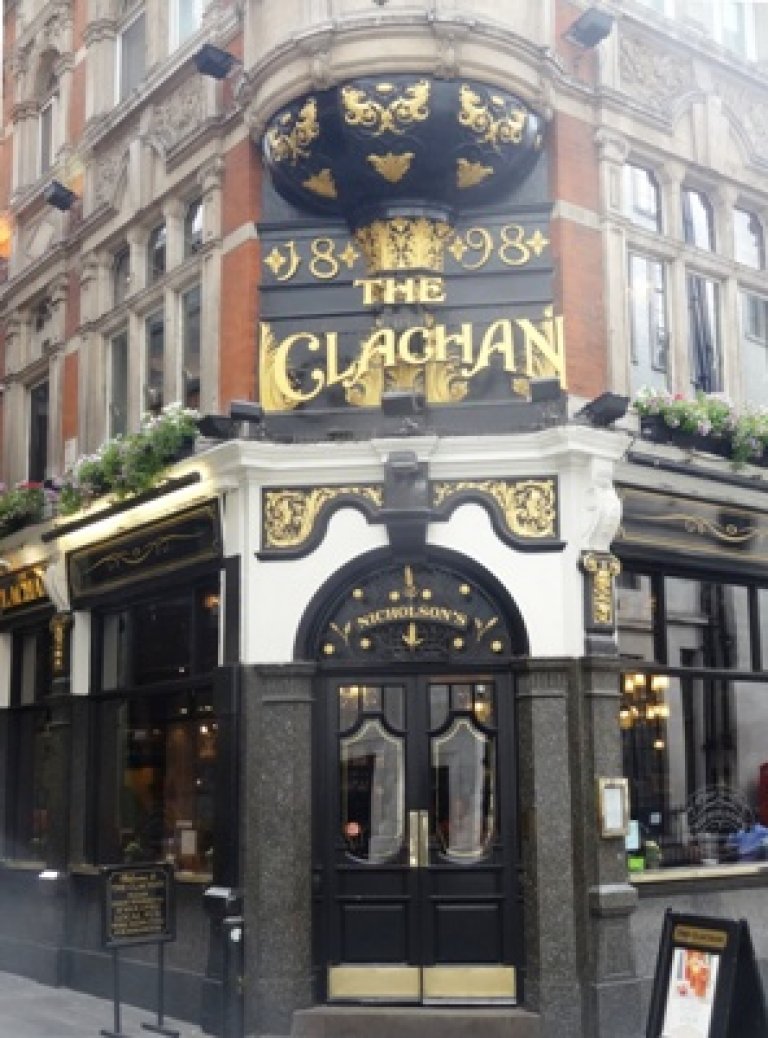Clachan
34 Kingly StreetSoho
W1B 5QH
Not only is this pub a grade II listed building it is also on CAMRA’s London Regional Inventory and the description is as follows: “A striking, loosely French Renaissance-style pub built of 1898. Two of the three entrances have mosaic flooring bearing the name of the pub. That on the Kingly Street side (with ornamental tiles on the wall) leads to a mosaic corridor which originally led to a door to the rear parts of the pub. Nowadays all the internal divisions have gone and one can circumnavigate the very impressive servery with its mahogany fittings. Much of the timber and etched and cut glass screenwork between the front and back parts of the pub is still in situ. The rear of the servery has a pleasing curved shaped counter. The ceiling is richly treated with Lincrusta panels. A notable and unusual feature is the raised snug at the rear with its iron rails and skylight. The Liberty Dining Room upstairs has a good fireplace (but modern bar fittings). The pub was once owned by the family-run Liberty department store which had plans to use it as a storehouse but then sold it off in 1993. Clachan is a Scottish word for hamlet but it is unknown what the connection was.”
The listing description is as follows: “Public House, 1898, designer unknown. Red brick with extensive pale cream limestone dressings, grey granite facing to lower part of ground floor facades, copper-sheathed roof to angle turret. EXTERIOR: Exuberant 'Free Renaissance' exterior on corner site, of three storeys with attic. Three bay main west elevation. Ground floor with central entrance comprising paired glazed doors set between granite pilasters with stylized Ionic capitals; large window to left over sloping granite dado; former angled entrance lobby to right, with mosaic decoration to threshold spelling out pub's name, and tiled decoration to wall. All glass to ground floor appears to be of a modern date and is plain: two or three-pane overlights to doors and windows, with narrow glazing bars. Fascia band at first floor level set between moulded consoles. First floor west elevation with single window over central entrance, six-light mullioned windows either side, all with flanking stylized Ionic capitals; heavy keystones over centres of side windows set against panels of acanthus decoration which form aprons to second floor side windows; these are paired arched casement windows with keystones, set between pilasters, with a pair of carved heads set against a foliate background in the spandrels above. The similar but single central window has lozenge decoration to the apron. Balustrade to parapet; mansard roof to attic with a pair of dormer windows flanking a projecting oval window with keystone, flanking scrolls and pediment. Entrance at north-west corner: arched doorway set between pilasters; pub name in affixed metal letters against acanthus leaf decoration above, with date of 1898 over. Projecting corner turret above in the French Renaissance style, with acanthus leaf decoration to oriel base, triple rectangular windows set between pilasters at second floor level, triple windows to top level beneath dentil cornice; domed roof with tall finial. North elevation similar to west, but with two storey bay at east end with triple doors, set beneath a framed inscription panel bearing the pub's name; part-concealed mosaic to threshold with pub's name inside door. INTERIOR: retains numerous fittings of note. Bar counter and elaborate back bar of mahogany, with cut glass mirror enrichment, in centre of ground floor. Raised snug at rear. Cast iron columns carry centre of coffered ceiling, which is covered with raised decoration. Stairs to first floor with square moulded balusters. First floor front room retains chimneypiece, panelled dado, raised decoration to ceiling. Upper floors, formerly publican's accommodation, retain numerous original fittings such as staircase, joinery, fireplaces. HISTORY: a good example of a Late Victorian 'Gin Palace', retaining its principal bar fixtures. Its elaborate decoration reflects its West End location and the heated competition between rival pubs for custom at this time. A 'clachan' is the Gaelic for a hamlet.”
The WhatPub link is here: WhatPub/Clachan
The Pub Heritage Group link is here: PHG/Clachan
The Clachan featured on the Evening Crawl of Soho in February 2002, and the Saints and Sinners: Evening Crawl of Covent Garden, Fitzrovia and Soho in April 2016.



